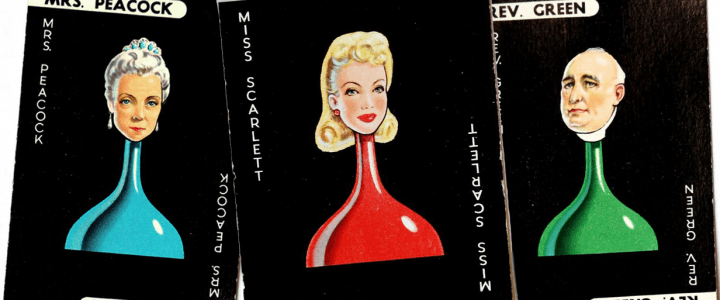Miss Scarlet with the lead piping...

We all love Cluedo, right? Well put it this way – I was far more likely to persuade the rest of my family to play this with me than the dreaded Monopoly, and as a budding sleuth I was always delighted when they agreed to investigate with me. Playing games together unites families, and it’s possibly our first exposure as children to what we might now call team building games.
It’s also the first time we recognise our different working patterns; we still laugh now about my Dad’s complicated note taking (which seemed methodical until he got the lead pipe mixed up with the revolver and his whole theory unraveled).
Even if they haven’t played, most people (of a certain age *ahem*) are very familiar with the characters, and you often hear phrases such as ‘it was Miss Scarlett in the Drawing Room with the Lead Piping’ bandied about when people are referring to an unsolved crime. I always found Colonel Mustard to be a bit suspicious, but I always wanted to be Miss Peacock. I didn’t remember why, but I did find this snippet quite interesting:
It was a race to eliminate suspects, locations and weapons one by one until you were left with the only possible correct combination (before anyone else reached the same conclusion). Of course, it was not only the direct answers you received which helped, but watching the reactions and actions of players when others took their turn.
You can see where I’m going here; key skills such as the application of logic, observation and negotiation were already coming into play (In the Living Room, with the Family, After Christmas). Having discovered the following passage, I can only conclude that I was playing at ‘expert’ level from a young age, based on my observation and note taking abilities!
- The complexity of note-taking can increase as a player becomes more skillful. Amateurs may simply mark off the cards they have been shown; more advanced players will keep track of who has and who does not have a particular card, possibly with the aid of an additional grid. Expert players may keep track of each suggestion made, knowing that the player who answers it must have at least one of the cards named; which one can be deduced by later events. One can also keep track of which cards a given player has seen, in order to minimize information revealed to that player and/or to read into that player’s suggestions.
Our Evidence Room is similar in some respects (not surprising given my childhood filled with Murder in the Dark and reading Agatha Christie and The Five Find Outers, amongst others). We know who the victim is, and we know who the suspects are. The murder weapon could be one of many; we simply have to work in teams to eliminate the innocent, whilst developing those all-important skills. There’s no trickery, it’s really quite simple, and it works.
I’m all for new and innovative ideas, but sometimes you realise that it’s safer not to meddle with the classics. In 2008 a new ‘Cluedo – Discover the Secrets’ version was released and included new locations such as a patio and spa, and such complicated madness as the introduction of ‘Intrigue cards’ comprising two types of cards, Keepers and Clocks. I don’t think anyone has ever quite worked out how or why they work, and don’t get me started on the new characters…
The changes to the game were widely criticised in the media and by lovers of the original game. Tellingly, as of December 2012, Hasbro no longer sells this version of the game via its website….

